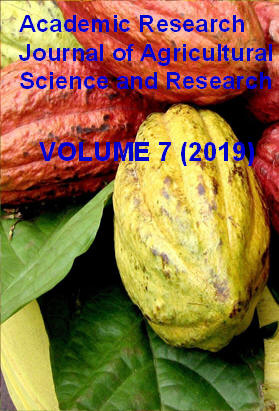| ARJASR |
Academic Research Journal of
Agricultural Science and Research |
|||||||||||||||||||
|
Vol. 7(1), pp. 42-48, January 2019 Full Length Research Growth and Yield Responses of Roselle (Hibiscus sabdariffa L.) Varieties to Different Common Bean (Phaseolus vulgaris L.) Planting Densities in Intercropping System. Dejene Tadesse Banjaw1, Mohamed Worku Adem2, Belstie Lulie1
1Ethiopian Institute of Agricultural Research, Wondo Genet Agricultural Research Center, 2Jimma University College of Agriculture and Veterinary Medicine *Corresponding Author: Dejene Tadesse Banjaw, Email: dejenebanjaw@gmail.com Mobile: +2510912217641/+2510925347350, P.O. box 198 Shashamane, Ethiopia.
Accepted 15 January 2019
This experiment was conducted at Hawassa, southern Ethiopia, during 2017/2018 to evaluate performance of roselle yield and yield components under intercropping system with different common bean planting densities. It was arranged in a 2x4 factorial in RCBD design and consisted of three replications and 11 treatments (sole cropping of two roselle varieties (WG-Hibiscus-Sudan and WG-Hibiscus-Jamaica) and a common bean variety (Ibbado) and four common bean planting densities combinations (25%, 50%, 75%, and 100%) with each roselle varieties. Yield and yield components data were collected and subjected to analysis of variance using SAS software version 9.3. Differences between means were assessed using Duncan`s Multiple Range Test at 5% probability level. Analysis of variance showed that the main factors interactions were nonsignificant in all parameters evaluated. Significant variations were recorded between two roselle varieties in all parameters evaluated. WG-Hibiscus-Jamaica was superior in all growth and yield parameters, except for thousand seed weight. Common bean planting density significantly influenced roselle seed yield per plant and dry calyx yield per hectare. Seed yields at 25% (46.6g) and for 50% (47.05g) common bean planting densities were statistically equivalent to that of 75% (40.65g) and 100% (39.27g) common bean planting densities. Roselle dry calyx yield was higher (0.88 t ha-1) for 25% and lower (0.74 t ha-1) for 100% common bean planting density. Besides, the intercropping reduced roselle seed yield per plant by 16.62% and dry calyx yield per hectare by 12.1% compared to roselle sole cropping. Hence, for higher roselle calyx yield per hectare, it is logical to suggest no more than 125,000 common bean plants per hectare for intercropping with both roselle varieties.
Keywords: Calyx, common bean, planting density
How to cite this article (APA Style): Dejene T.B., Mohamed, W.A., Belstie, L. (2019). Growth and Yield Responses of Roselle (Hibiscus sabdariffa L.) Varieties to Different Common Bean (Phaseolus vulgaris L.) Planting Densities in Intercropping System.. Acad. Res. J. Agri. Sci. Res. 7(1): 42-48
|
|||||||||||||||||||
